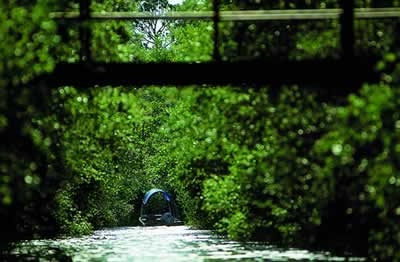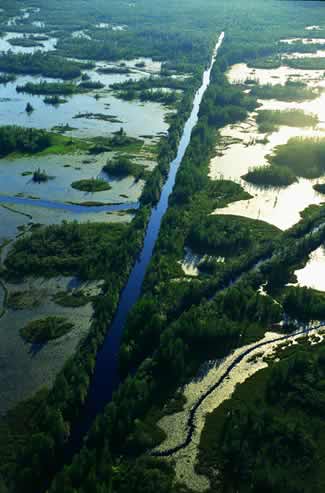
The Natural Georgia Series: The Okefenokee Swamp

 |
The Natural Georgia Series: The Okefenokee Swamp |
 |
Most of the Okefenokee Swamp was unsurveyed public land until 1891. It was
property of the State of Georgia. Isolated in the depths of the piney woods,
only a few hunting and stockminding families settled in and around the great
swamp. It was considered to be a worthless place.
The Georgia Legislature in 1889 authorized the Governor to sell the property
to the highest bidder. A syndicate of wealthy capitalists and former Confederate
officers offered 26.5 cents per acre for the property. They were granted a charter
as The Suwanee Canal Company in 1890, and in January 1891 this company paid
the State $63,101.80 for 238,120 acres.

For the next six years this company attempted to develop the land. First,
they attempted to drain the swamp. Later they built a cypress lumber sawmill.
They hoped to sell the drained land for rice, sugar cane, and cotton plantations;
they also hoped to harvest and sell the timber. Captain Henry Jackson of Atlanta
was named president of the company.
Work on the drainage ditch from the swamp to the St. Marys River began on
September 20, 1891. The drainage project continued for three years despite many
problems. The sides of the drainage ditch collapsed because of poor engineering
design and bad weather. Leased convict labor, large steam shovels, and finally
gold miners from north Georgia using large water hoses were unable to dig the
ditch deep enough through Trail Ridge to drain the swamp. Steam dredges were
purchased to dig canals westward across the prairies. The owners of the company
exhausted their funds. The drainage effort was abandoned in October 1894.
In 1894, the company built a large sawmill at Camp Cornelia and constructed
a railroad from Folkston to the mill. The canal was dredged further west across
the marshy prairies and a steamboat and industrial logging equipment were purchased
to harvest and haul rafts of cypress logs to the sawmill at Camp Cornelia. The
company was one of the first cypress companies in the nation to use industrial
logging equipment.
Large steam logging skidders and logging pullboats were used to harvest the
logs. Formed into rafts, the logs were towed to the sawmill by steamboats. Over
7,000,000 feet of lumber were produced and almost 20 miles of canals were dredged.
The work continued night and day. Electric lights were used at night. The company
hoped to raise enough money from the lumber to continue the drainage project.
But the company found it impossible to produce the lumber profitably. The
market was flooded with lumber, and they could not sell the lumber that was
produced at a high enough price. High freight rates devoured the profits from
the lumber that could be sold. The company borrowed money. Then on Friday, December
13, 1895, Captain Jackson died following an operation for appendicitis.
General Henry R. Jackson of Savannah, his father, was elected president in
December 1895. He loaned more money to the company. The company survived on
the General's money until 1897, when he would lend no more.
When the company could not pay its debts the courts placed the company in
the hands of a receiver in June 1897. The receiver, Joel Hurt of Atlanta, attempted
to operate the company for several months, but he also found the business to
be unprofitable.
In 1899, the property of The Suwanee Canal Company was sold to members of
the Jackson family as part of the "Jackson Trust." The family trustee
was the Honorable Pope Barrow, General Jackson's son-in-law. The Jackson family
owned most of the stock and mortgage bonds of the company. In 1901, the property
was sold by the Jackson Trust to Charles Hebard, a prominent lumberman of Philadelphia
and the Hebard Lumber Company of Lowndes County, Georgia.
The Suwannee Canal survives as the principal waterway into the heart of the swamp. Hundreds of thousands of visitors enjoy the refuge of the wilderness each year via this route, a legacy of "Jackson's hobby," the company that failed.
Read and add comments about this page
Go back to previous page. Go to Okefenokee Swamp contents page. Go to Sherpa Guides home.
[ Previous Topic | Next Topic ]